Financial Decision Making: Skanska Plc Analysis and Performance
VerifiedAdded on 2023/01/09
|11
|3689
|72
Report
AI Summary
This report provides a comprehensive financial analysis of Skanska Plc, a UK-based construction company. It begins with a critical evaluation of the importance of accounting and finance functions, duties, and roles within the organization, detailing aspects like generating final accounts, evaluating performance, complying with regulations, and formulating future decisions. The report then calculates various financial ratios, including return on capital employed, net profit margin, current ratio, and average receivable days, to assess Skanska's financial performance. The ratio analysis is followed by an investor perspective, offering insights and recommendations based on the calculated ratios. The report concludes with a summary of findings and recommendations, emphasizing the importance of financial decision-making for Skanska Plc's future success.

FINANCIAL
DECISION MAKING
DECISION MAKING
Paraphrase This Document
Need a fresh take? Get an instant paraphrase of this document with our AI Paraphraser
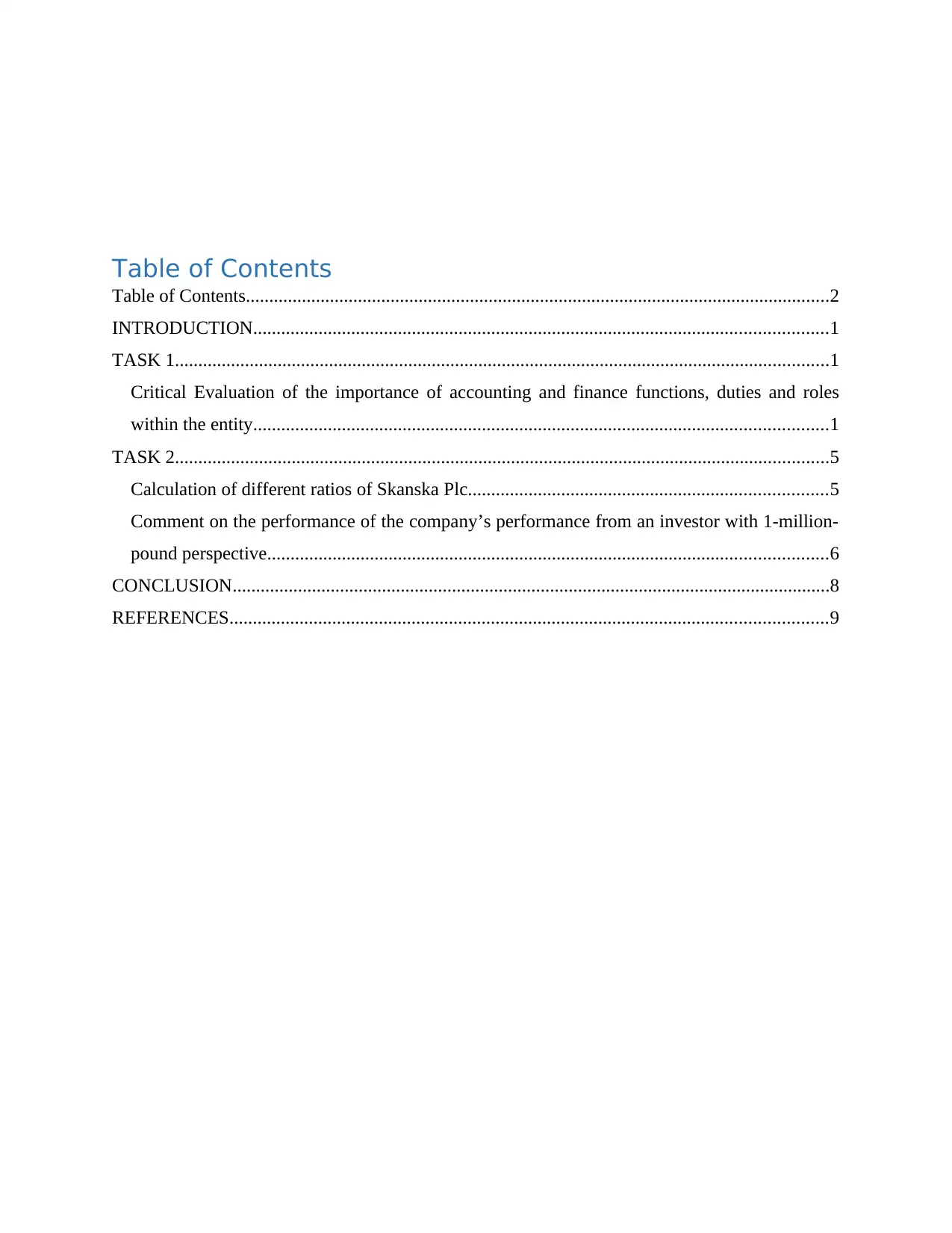
Table of Contents
Table of Contents.............................................................................................................................2
INTRODUCTION...........................................................................................................................1
TASK 1............................................................................................................................................1
Critical Evaluation of the importance of accounting and finance functions, duties and roles
within the entity...........................................................................................................................1
TASK 2............................................................................................................................................5
Calculation of different ratios of Skanska Plc.............................................................................5
Comment on the performance of the company’s performance from an investor with 1-million-
pound perspective........................................................................................................................6
CONCLUSION................................................................................................................................8
REFERENCES................................................................................................................................9
Table of Contents.............................................................................................................................2
INTRODUCTION...........................................................................................................................1
TASK 1............................................................................................................................................1
Critical Evaluation of the importance of accounting and finance functions, duties and roles
within the entity...........................................................................................................................1
TASK 2............................................................................................................................................5
Calculation of different ratios of Skanska Plc.............................................................................5
Comment on the performance of the company’s performance from an investor with 1-million-
pound perspective........................................................................................................................6
CONCLUSION................................................................................................................................8
REFERENCES................................................................................................................................9
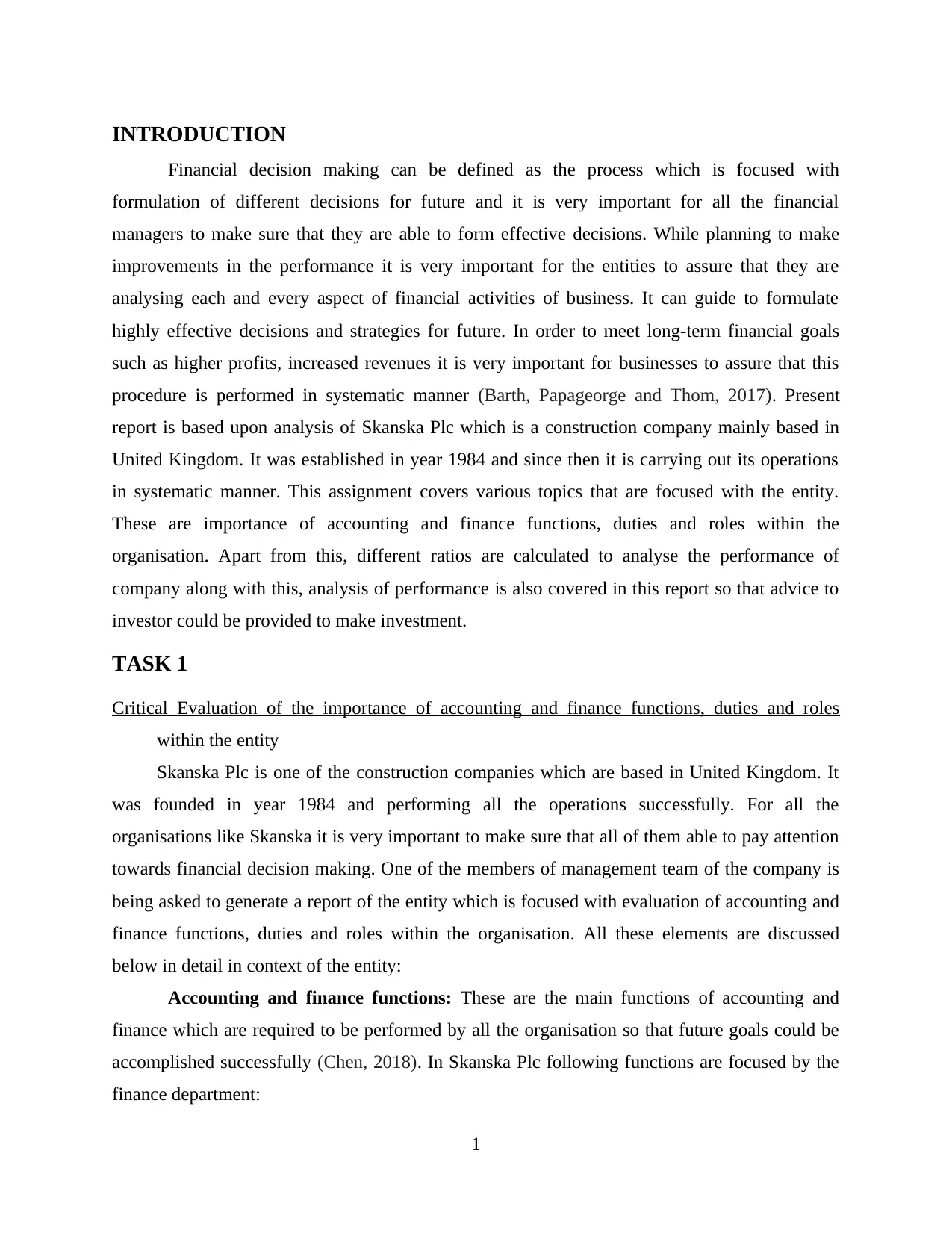
INTRODUCTION
Financial decision making can be defined as the process which is focused with
formulation of different decisions for future and it is very important for all the financial
managers to make sure that they are able to form effective decisions. While planning to make
improvements in the performance it is very important for the entities to assure that they are
analysing each and every aspect of financial activities of business. It can guide to formulate
highly effective decisions and strategies for future. In order to meet long-term financial goals
such as higher profits, increased revenues it is very important for businesses to assure that this
procedure is performed in systematic manner (Barth, Papageorge and Thom, 2017). Present
report is based upon analysis of Skanska Plc which is a construction company mainly based in
United Kingdom. It was established in year 1984 and since then it is carrying out its operations
in systematic manner. This assignment covers various topics that are focused with the entity.
These are importance of accounting and finance functions, duties and roles within the
organisation. Apart from this, different ratios are calculated to analyse the performance of
company along with this, analysis of performance is also covered in this report so that advice to
investor could be provided to make investment.
TASK 1
Critical Evaluation of the importance of accounting and finance functions, duties and roles
within the entity
Skanska Plc is one of the construction companies which are based in United Kingdom. It
was founded in year 1984 and performing all the operations successfully. For all the
organisations like Skanska it is very important to make sure that all of them able to pay attention
towards financial decision making. One of the members of management team of the company is
being asked to generate a report of the entity which is focused with evaluation of accounting and
finance functions, duties and roles within the organisation. All these elements are discussed
below in detail in context of the entity:
Accounting and finance functions: These are the main functions of accounting and
finance which are required to be performed by all the organisation so that future goals could be
accomplished successfully (Chen, 2018). In Skanska Plc following functions are focused by the
finance department:
1
Financial decision making can be defined as the process which is focused with
formulation of different decisions for future and it is very important for all the financial
managers to make sure that they are able to form effective decisions. While planning to make
improvements in the performance it is very important for the entities to assure that they are
analysing each and every aspect of financial activities of business. It can guide to formulate
highly effective decisions and strategies for future. In order to meet long-term financial goals
such as higher profits, increased revenues it is very important for businesses to assure that this
procedure is performed in systematic manner (Barth, Papageorge and Thom, 2017). Present
report is based upon analysis of Skanska Plc which is a construction company mainly based in
United Kingdom. It was established in year 1984 and since then it is carrying out its operations
in systematic manner. This assignment covers various topics that are focused with the entity.
These are importance of accounting and finance functions, duties and roles within the
organisation. Apart from this, different ratios are calculated to analyse the performance of
company along with this, analysis of performance is also covered in this report so that advice to
investor could be provided to make investment.
TASK 1
Critical Evaluation of the importance of accounting and finance functions, duties and roles
within the entity
Skanska Plc is one of the construction companies which are based in United Kingdom. It
was founded in year 1984 and performing all the operations successfully. For all the
organisations like Skanska it is very important to make sure that all of them able to pay attention
towards financial decision making. One of the members of management team of the company is
being asked to generate a report of the entity which is focused with evaluation of accounting and
finance functions, duties and roles within the organisation. All these elements are discussed
below in detail in context of the entity:
Accounting and finance functions: These are the main functions of accounting and
finance which are required to be performed by all the organisation so that future goals could be
accomplished successfully (Chen, 2018). In Skanska Plc following functions are focused by the
finance department:
1
⊘ This is a preview!⊘
Do you want full access?
Subscribe today to unlock all pages.

Trusted by 1+ million students worldwide
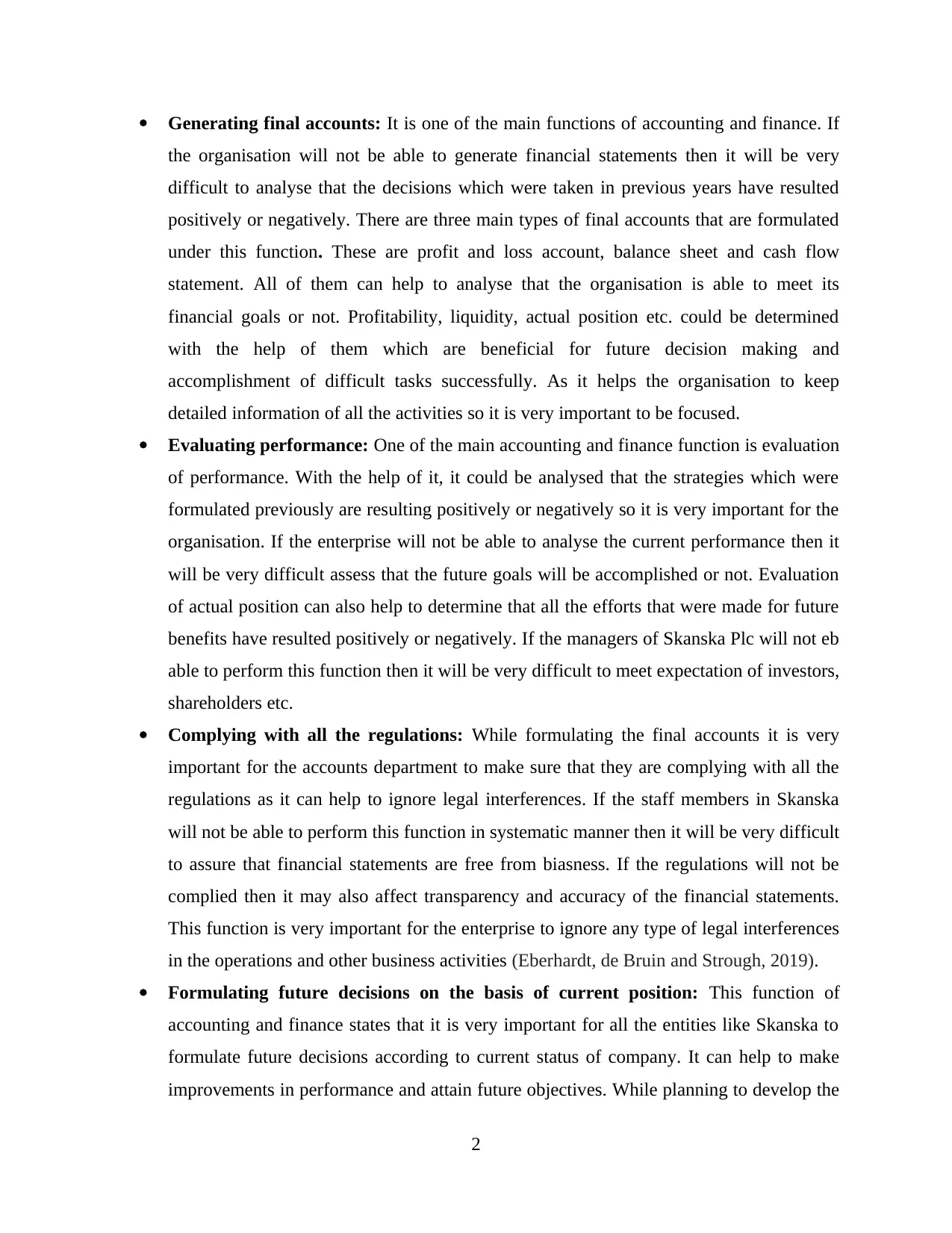
Generating final accounts: It is one of the main functions of accounting and finance. If
the organisation will not be able to generate financial statements then it will be very
difficult to analyse that the decisions which were taken in previous years have resulted
positively or negatively. There are three main types of final accounts that are formulated
under this function. These are profit and loss account, balance sheet and cash flow
statement. All of them can help to analyse that the organisation is able to meet its
financial goals or not. Profitability, liquidity, actual position etc. could be determined
with the help of them which are beneficial for future decision making and
accomplishment of difficult tasks successfully. As it helps the organisation to keep
detailed information of all the activities so it is very important to be focused.
Evaluating performance: One of the main accounting and finance function is evaluation
of performance. With the help of it, it could be analysed that the strategies which were
formulated previously are resulting positively or negatively so it is very important for the
organisation. If the enterprise will not be able to analyse the current performance then it
will be very difficult assess that the future goals will be accomplished or not. Evaluation
of actual position can also help to determine that all the efforts that were made for future
benefits have resulted positively or negatively. If the managers of Skanska Plc will not eb
able to perform this function then it will be very difficult to meet expectation of investors,
shareholders etc.
Complying with all the regulations: While formulating the final accounts it is very
important for the accounts department to make sure that they are complying with all the
regulations as it can help to ignore legal interferences. If the staff members in Skanska
will not be able to perform this function in systematic manner then it will be very difficult
to assure that financial statements are free from biasness. If the regulations will not be
complied then it may also affect transparency and accuracy of the financial statements.
This function is very important for the enterprise to ignore any type of legal interferences
in the operations and other business activities (Eberhardt, de Bruin and Strough, 2019).
Formulating future decisions on the basis of current position: This function of
accounting and finance states that it is very important for all the entities like Skanska to
formulate future decisions according to current status of company. It can help to make
improvements in performance and attain future objectives. While planning to develop the
2
the organisation will not be able to generate financial statements then it will be very
difficult to analyse that the decisions which were taken in previous years have resulted
positively or negatively. There are three main types of final accounts that are formulated
under this function. These are profit and loss account, balance sheet and cash flow
statement. All of them can help to analyse that the organisation is able to meet its
financial goals or not. Profitability, liquidity, actual position etc. could be determined
with the help of them which are beneficial for future decision making and
accomplishment of difficult tasks successfully. As it helps the organisation to keep
detailed information of all the activities so it is very important to be focused.
Evaluating performance: One of the main accounting and finance function is evaluation
of performance. With the help of it, it could be analysed that the strategies which were
formulated previously are resulting positively or negatively so it is very important for the
organisation. If the enterprise will not be able to analyse the current performance then it
will be very difficult assess that the future goals will be accomplished or not. Evaluation
of actual position can also help to determine that all the efforts that were made for future
benefits have resulted positively or negatively. If the managers of Skanska Plc will not eb
able to perform this function then it will be very difficult to meet expectation of investors,
shareholders etc.
Complying with all the regulations: While formulating the final accounts it is very
important for the accounts department to make sure that they are complying with all the
regulations as it can help to ignore legal interferences. If the staff members in Skanska
will not be able to perform this function in systematic manner then it will be very difficult
to assure that financial statements are free from biasness. If the regulations will not be
complied then it may also affect transparency and accuracy of the financial statements.
This function is very important for the enterprise to ignore any type of legal interferences
in the operations and other business activities (Eberhardt, de Bruin and Strough, 2019).
Formulating future decisions on the basis of current position: This function of
accounting and finance states that it is very important for all the entities like Skanska to
formulate future decisions according to current status of company. It can help to make
improvements in performance and attain future objectives. While planning to develop the
2
Paraphrase This Document
Need a fresh take? Get an instant paraphrase of this document with our AI Paraphraser
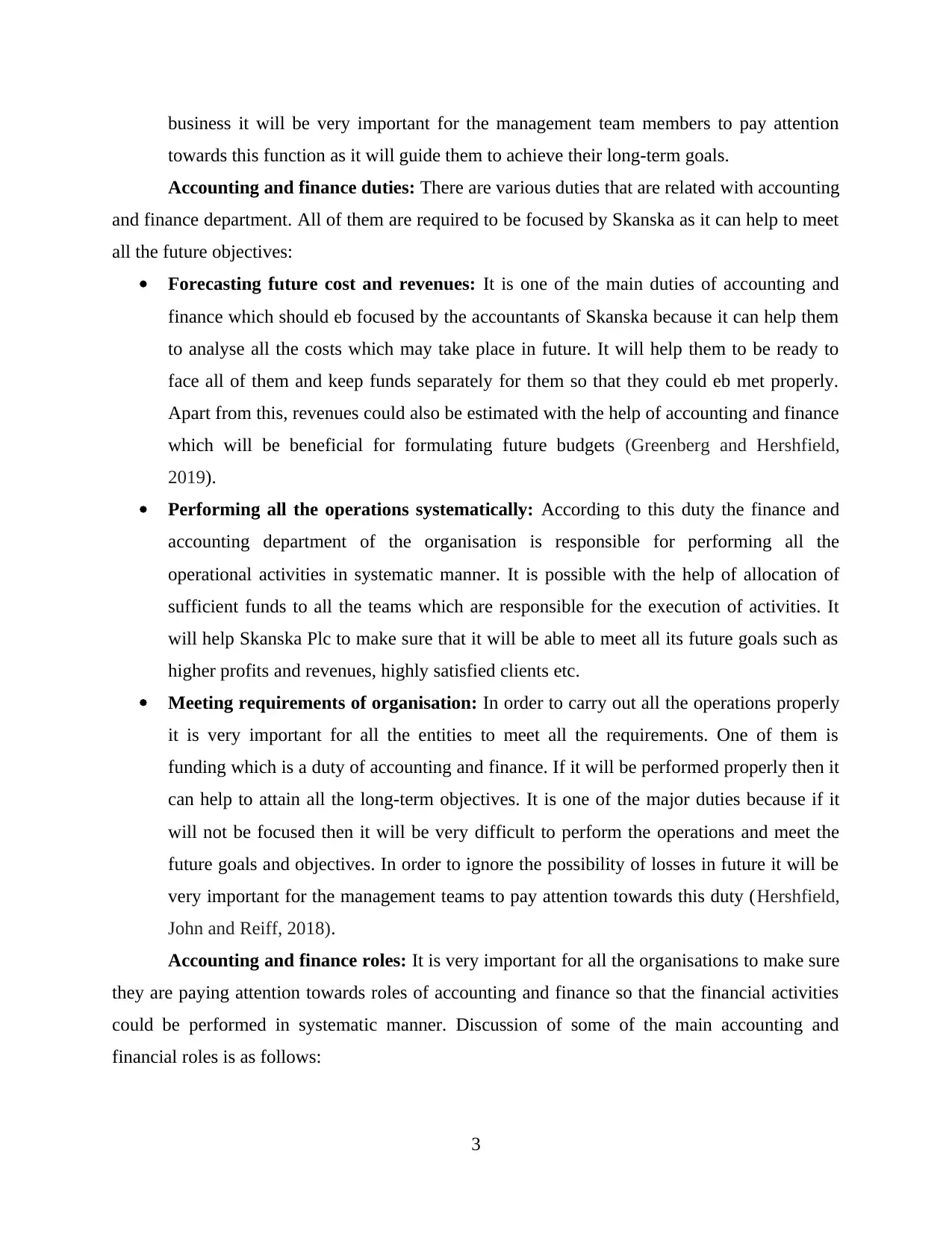
business it will be very important for the management team members to pay attention
towards this function as it will guide them to achieve their long-term goals.
Accounting and finance duties: There are various duties that are related with accounting
and finance department. All of them are required to be focused by Skanska as it can help to meet
all the future objectives:
Forecasting future cost and revenues: It is one of the main duties of accounting and
finance which should eb focused by the accountants of Skanska because it can help them
to analyse all the costs which may take place in future. It will help them to be ready to
face all of them and keep funds separately for them so that they could eb met properly.
Apart from this, revenues could also be estimated with the help of accounting and finance
which will be beneficial for formulating future budgets (Greenberg and Hershfield,
2019).
Performing all the operations systematically: According to this duty the finance and
accounting department of the organisation is responsible for performing all the
operational activities in systematic manner. It is possible with the help of allocation of
sufficient funds to all the teams which are responsible for the execution of activities. It
will help Skanska Plc to make sure that it will be able to meet all its future goals such as
higher profits and revenues, highly satisfied clients etc.
Meeting requirements of organisation: In order to carry out all the operations properly
it is very important for all the entities to meet all the requirements. One of them is
funding which is a duty of accounting and finance. If it will be performed properly then it
can help to attain all the long-term objectives. It is one of the major duties because if it
will not be focused then it will be very difficult to perform the operations and meet the
future goals and objectives. In order to ignore the possibility of losses in future it will be
very important for the management teams to pay attention towards this duty (Hershfield,
John and Reiff, 2018).
Accounting and finance roles: It is very important for all the organisations to make sure
they are paying attention towards roles of accounting and finance so that the financial activities
could be performed in systematic manner. Discussion of some of the main accounting and
financial roles is as follows:
3
towards this function as it will guide them to achieve their long-term goals.
Accounting and finance duties: There are various duties that are related with accounting
and finance department. All of them are required to be focused by Skanska as it can help to meet
all the future objectives:
Forecasting future cost and revenues: It is one of the main duties of accounting and
finance which should eb focused by the accountants of Skanska because it can help them
to analyse all the costs which may take place in future. It will help them to be ready to
face all of them and keep funds separately for them so that they could eb met properly.
Apart from this, revenues could also be estimated with the help of accounting and finance
which will be beneficial for formulating future budgets (Greenberg and Hershfield,
2019).
Performing all the operations systematically: According to this duty the finance and
accounting department of the organisation is responsible for performing all the
operational activities in systematic manner. It is possible with the help of allocation of
sufficient funds to all the teams which are responsible for the execution of activities. It
will help Skanska Plc to make sure that it will be able to meet all its future goals such as
higher profits and revenues, highly satisfied clients etc.
Meeting requirements of organisation: In order to carry out all the operations properly
it is very important for all the entities to meet all the requirements. One of them is
funding which is a duty of accounting and finance. If it will be performed properly then it
can help to attain all the long-term objectives. It is one of the major duties because if it
will not be focused then it will be very difficult to perform the operations and meet the
future goals and objectives. In order to ignore the possibility of losses in future it will be
very important for the management teams to pay attention towards this duty (Hershfield,
John and Reiff, 2018).
Accounting and finance roles: It is very important for all the organisations to make sure
they are paying attention towards roles of accounting and finance so that the financial activities
could be performed in systematic manner. Discussion of some of the main accounting and
financial roles is as follows:
3
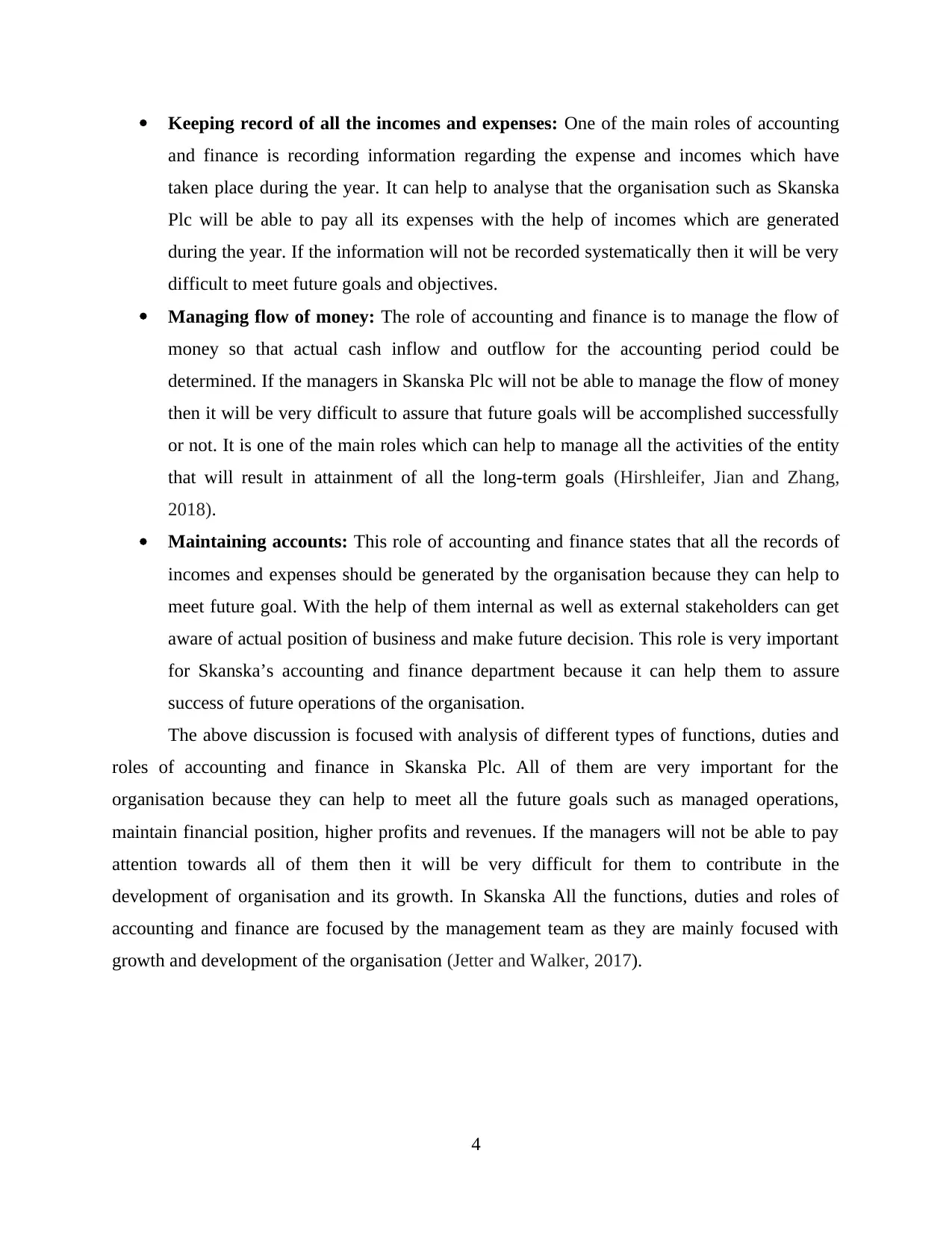
Keeping record of all the incomes and expenses: One of the main roles of accounting
and finance is recording information regarding the expense and incomes which have
taken place during the year. It can help to analyse that the organisation such as Skanska
Plc will be able to pay all its expenses with the help of incomes which are generated
during the year. If the information will not be recorded systematically then it will be very
difficult to meet future goals and objectives.
Managing flow of money: The role of accounting and finance is to manage the flow of
money so that actual cash inflow and outflow for the accounting period could be
determined. If the managers in Skanska Plc will not be able to manage the flow of money
then it will be very difficult to assure that future goals will be accomplished successfully
or not. It is one of the main roles which can help to manage all the activities of the entity
that will result in attainment of all the long-term goals (Hirshleifer, Jian and Zhang,
2018).
Maintaining accounts: This role of accounting and finance states that all the records of
incomes and expenses should be generated by the organisation because they can help to
meet future goal. With the help of them internal as well as external stakeholders can get
aware of actual position of business and make future decision. This role is very important
for Skanska’s accounting and finance department because it can help them to assure
success of future operations of the organisation.
The above discussion is focused with analysis of different types of functions, duties and
roles of accounting and finance in Skanska Plc. All of them are very important for the
organisation because they can help to meet all the future goals such as managed operations,
maintain financial position, higher profits and revenues. If the managers will not be able to pay
attention towards all of them then it will be very difficult for them to contribute in the
development of organisation and its growth. In Skanska All the functions, duties and roles of
accounting and finance are focused by the management team as they are mainly focused with
growth and development of the organisation (Jetter and Walker, 2017).
4
and finance is recording information regarding the expense and incomes which have
taken place during the year. It can help to analyse that the organisation such as Skanska
Plc will be able to pay all its expenses with the help of incomes which are generated
during the year. If the information will not be recorded systematically then it will be very
difficult to meet future goals and objectives.
Managing flow of money: The role of accounting and finance is to manage the flow of
money so that actual cash inflow and outflow for the accounting period could be
determined. If the managers in Skanska Plc will not be able to manage the flow of money
then it will be very difficult to assure that future goals will be accomplished successfully
or not. It is one of the main roles which can help to manage all the activities of the entity
that will result in attainment of all the long-term goals (Hirshleifer, Jian and Zhang,
2018).
Maintaining accounts: This role of accounting and finance states that all the records of
incomes and expenses should be generated by the organisation because they can help to
meet future goal. With the help of them internal as well as external stakeholders can get
aware of actual position of business and make future decision. This role is very important
for Skanska’s accounting and finance department because it can help them to assure
success of future operations of the organisation.
The above discussion is focused with analysis of different types of functions, duties and
roles of accounting and finance in Skanska Plc. All of them are very important for the
organisation because they can help to meet all the future goals such as managed operations,
maintain financial position, higher profits and revenues. If the managers will not be able to pay
attention towards all of them then it will be very difficult for them to contribute in the
development of organisation and its growth. In Skanska All the functions, duties and roles of
accounting and finance are focused by the management team as they are mainly focused with
growth and development of the organisation (Jetter and Walker, 2017).
4
⊘ This is a preview!⊘
Do you want full access?
Subscribe today to unlock all pages.

Trusted by 1+ million students worldwide
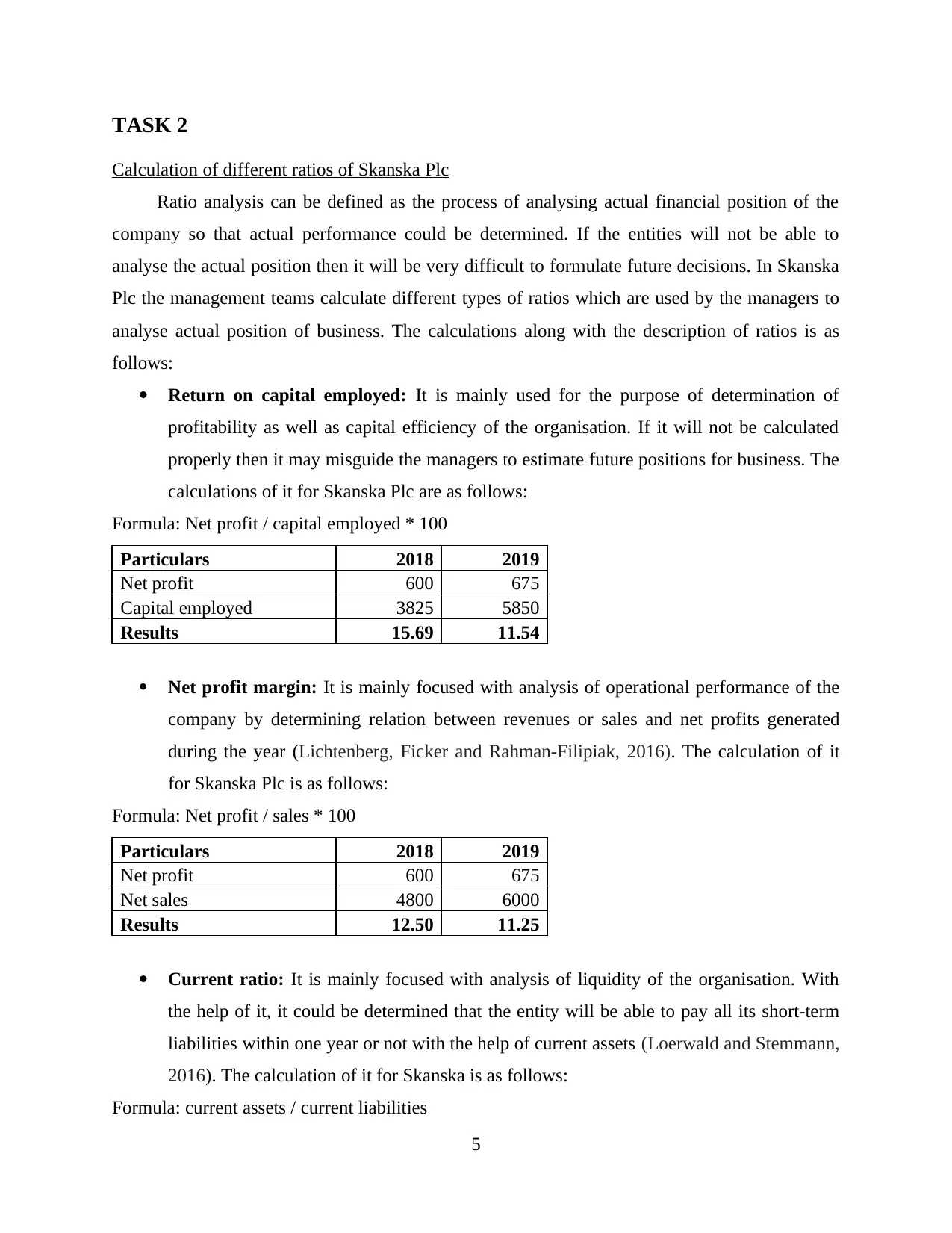
TASK 2
Calculation of different ratios of Skanska Plc
Ratio analysis can be defined as the process of analysing actual financial position of the
company so that actual performance could be determined. If the entities will not be able to
analyse the actual position then it will be very difficult to formulate future decisions. In Skanska
Plc the management teams calculate different types of ratios which are used by the managers to
analyse actual position of business. The calculations along with the description of ratios is as
follows:
Return on capital employed: It is mainly used for the purpose of determination of
profitability as well as capital efficiency of the organisation. If it will not be calculated
properly then it may misguide the managers to estimate future positions for business. The
calculations of it for Skanska Plc are as follows:
Formula: Net profit / capital employed * 100
Particulars 2018 2019
Net profit 600 675
Capital employed 3825 5850
Results 15.69 11.54
Net profit margin: It is mainly focused with analysis of operational performance of the
company by determining relation between revenues or sales and net profits generated
during the year (Lichtenberg, Ficker and Rahman-Filipiak, 2016). The calculation of it
for Skanska Plc is as follows:
Formula: Net profit / sales * 100
Particulars 2018 2019
Net profit 600 675
Net sales 4800 6000
Results 12.50 11.25
Current ratio: It is mainly focused with analysis of liquidity of the organisation. With
the help of it, it could be determined that the entity will be able to pay all its short-term
liabilities within one year or not with the help of current assets (Loerwald and Stemmann,
2016). The calculation of it for Skanska is as follows:
Formula: current assets / current liabilities
5
Calculation of different ratios of Skanska Plc
Ratio analysis can be defined as the process of analysing actual financial position of the
company so that actual performance could be determined. If the entities will not be able to
analyse the actual position then it will be very difficult to formulate future decisions. In Skanska
Plc the management teams calculate different types of ratios which are used by the managers to
analyse actual position of business. The calculations along with the description of ratios is as
follows:
Return on capital employed: It is mainly used for the purpose of determination of
profitability as well as capital efficiency of the organisation. If it will not be calculated
properly then it may misguide the managers to estimate future positions for business. The
calculations of it for Skanska Plc are as follows:
Formula: Net profit / capital employed * 100
Particulars 2018 2019
Net profit 600 675
Capital employed 3825 5850
Results 15.69 11.54
Net profit margin: It is mainly focused with analysis of operational performance of the
company by determining relation between revenues or sales and net profits generated
during the year (Lichtenberg, Ficker and Rahman-Filipiak, 2016). The calculation of it
for Skanska Plc is as follows:
Formula: Net profit / sales * 100
Particulars 2018 2019
Net profit 600 675
Net sales 4800 6000
Results 12.50 11.25
Current ratio: It is mainly focused with analysis of liquidity of the organisation. With
the help of it, it could be determined that the entity will be able to pay all its short-term
liabilities within one year or not with the help of current assets (Loerwald and Stemmann,
2016). The calculation of it for Skanska is as follows:
Formula: current assets / current liabilities
5
Paraphrase This Document
Need a fresh take? Get an instant paraphrase of this document with our AI Paraphraser
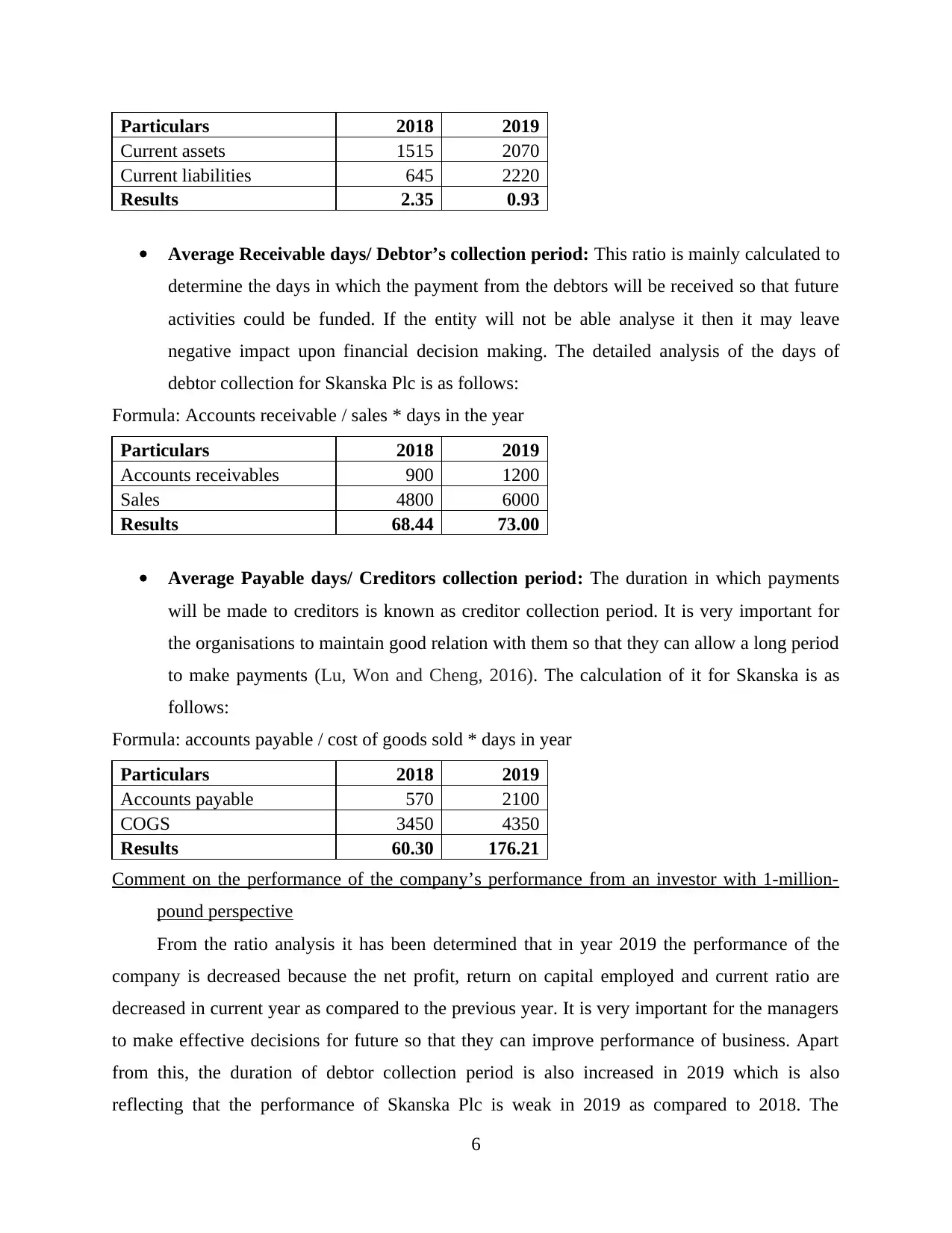
Particulars 2018 2019
Current assets 1515 2070
Current liabilities 645 2220
Results 2.35 0.93
Average Receivable days/ Debtor’s collection period: This ratio is mainly calculated to
determine the days in which the payment from the debtors will be received so that future
activities could be funded. If the entity will not be able analyse it then it may leave
negative impact upon financial decision making. The detailed analysis of the days of
debtor collection for Skanska Plc is as follows:
Formula: Accounts receivable / sales * days in the year
Particulars 2018 2019
Accounts receivables 900 1200
Sales 4800 6000
Results 68.44 73.00
Average Payable days/ Creditors collection period: The duration in which payments
will be made to creditors is known as creditor collection period. It is very important for
the organisations to maintain good relation with them so that they can allow a long period
to make payments (Lu, Won and Cheng, 2016). The calculation of it for Skanska is as
follows:
Formula: accounts payable / cost of goods sold * days in year
Particulars 2018 2019
Accounts payable 570 2100
COGS 3450 4350
Results 60.30 176.21
Comment on the performance of the company’s performance from an investor with 1-million-
pound perspective
From the ratio analysis it has been determined that in year 2019 the performance of the
company is decreased because the net profit, return on capital employed and current ratio are
decreased in current year as compared to the previous year. It is very important for the managers
to make effective decisions for future so that they can improve performance of business. Apart
from this, the duration of debtor collection period is also increased in 2019 which is also
reflecting that the performance of Skanska Plc is weak in 2019 as compared to 2018. The
6
Current assets 1515 2070
Current liabilities 645 2220
Results 2.35 0.93
Average Receivable days/ Debtor’s collection period: This ratio is mainly calculated to
determine the days in which the payment from the debtors will be received so that future
activities could be funded. If the entity will not be able analyse it then it may leave
negative impact upon financial decision making. The detailed analysis of the days of
debtor collection for Skanska Plc is as follows:
Formula: Accounts receivable / sales * days in the year
Particulars 2018 2019
Accounts receivables 900 1200
Sales 4800 6000
Results 68.44 73.00
Average Payable days/ Creditors collection period: The duration in which payments
will be made to creditors is known as creditor collection period. It is very important for
the organisations to maintain good relation with them so that they can allow a long period
to make payments (Lu, Won and Cheng, 2016). The calculation of it for Skanska is as
follows:
Formula: accounts payable / cost of goods sold * days in year
Particulars 2018 2019
Accounts payable 570 2100
COGS 3450 4350
Results 60.30 176.21
Comment on the performance of the company’s performance from an investor with 1-million-
pound perspective
From the ratio analysis it has been determined that in year 2019 the performance of the
company is decreased because the net profit, return on capital employed and current ratio are
decreased in current year as compared to the previous year. It is very important for the managers
to make effective decisions for future so that they can improve performance of business. Apart
from this, the duration of debtor collection period is also increased in 2019 which is also
reflecting that the performance of Skanska Plc is weak in 2019 as compared to 2018. The
6
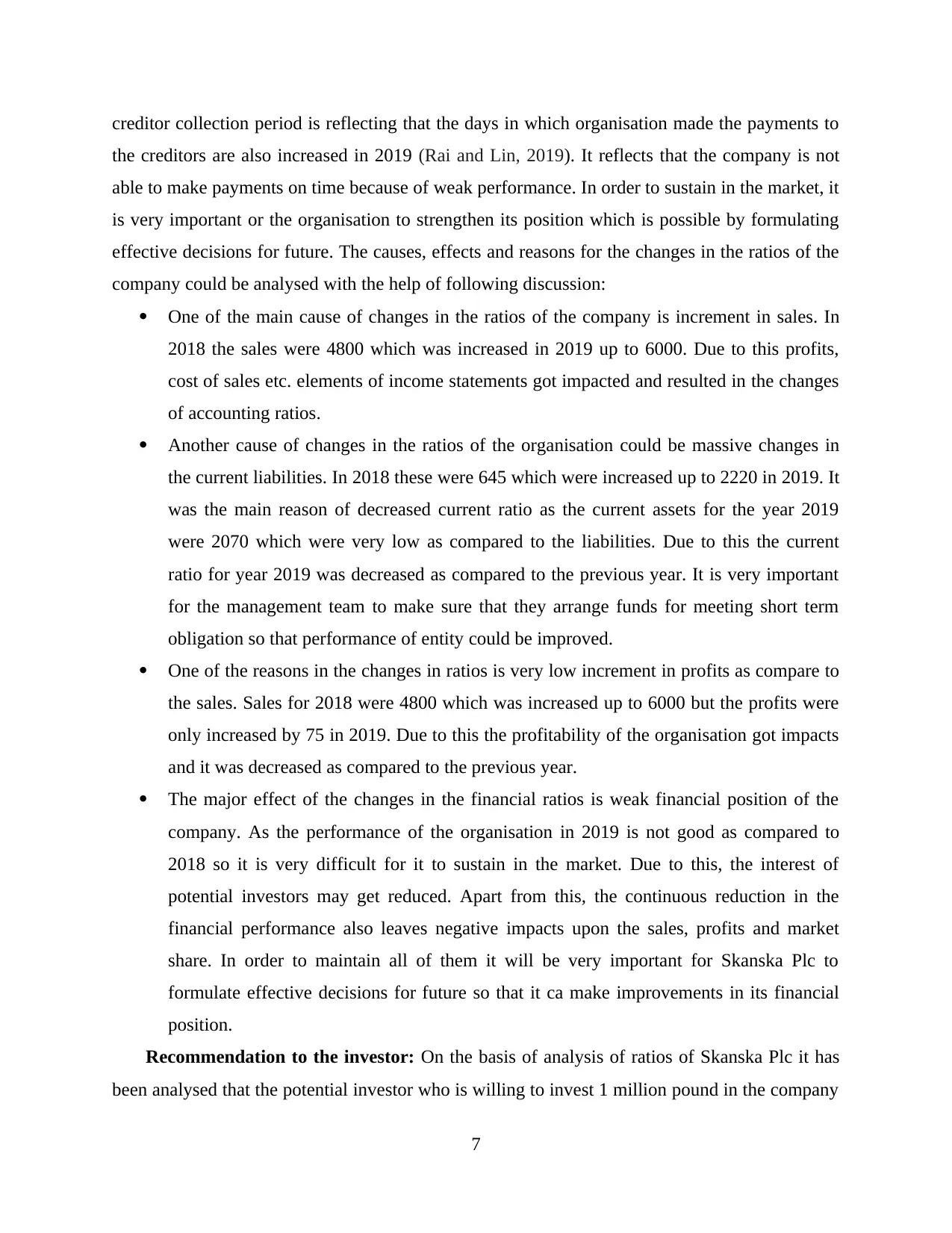
creditor collection period is reflecting that the days in which organisation made the payments to
the creditors are also increased in 2019 (Rai and Lin, 2019). It reflects that the company is not
able to make payments on time because of weak performance. In order to sustain in the market, it
is very important or the organisation to strengthen its position which is possible by formulating
effective decisions for future. The causes, effects and reasons for the changes in the ratios of the
company could be analysed with the help of following discussion:
One of the main cause of changes in the ratios of the company is increment in sales. In
2018 the sales were 4800 which was increased in 2019 up to 6000. Due to this profits,
cost of sales etc. elements of income statements got impacted and resulted in the changes
of accounting ratios.
Another cause of changes in the ratios of the organisation could be massive changes in
the current liabilities. In 2018 these were 645 which were increased up to 2220 in 2019. It
was the main reason of decreased current ratio as the current assets for the year 2019
were 2070 which were very low as compared to the liabilities. Due to this the current
ratio for year 2019 was decreased as compared to the previous year. It is very important
for the management team to make sure that they arrange funds for meeting short term
obligation so that performance of entity could be improved.
One of the reasons in the changes in ratios is very low increment in profits as compare to
the sales. Sales for 2018 were 4800 which was increased up to 6000 but the profits were
only increased by 75 in 2019. Due to this the profitability of the organisation got impacts
and it was decreased as compared to the previous year.
The major effect of the changes in the financial ratios is weak financial position of the
company. As the performance of the organisation in 2019 is not good as compared to
2018 so it is very difficult for it to sustain in the market. Due to this, the interest of
potential investors may get reduced. Apart from this, the continuous reduction in the
financial performance also leaves negative impacts upon the sales, profits and market
share. In order to maintain all of them it will be very important for Skanska Plc to
formulate effective decisions for future so that it ca make improvements in its financial
position.
Recommendation to the investor: On the basis of analysis of ratios of Skanska Plc it has
been analysed that the potential investor who is willing to invest 1 million pound in the company
7
the creditors are also increased in 2019 (Rai and Lin, 2019). It reflects that the company is not
able to make payments on time because of weak performance. In order to sustain in the market, it
is very important or the organisation to strengthen its position which is possible by formulating
effective decisions for future. The causes, effects and reasons for the changes in the ratios of the
company could be analysed with the help of following discussion:
One of the main cause of changes in the ratios of the company is increment in sales. In
2018 the sales were 4800 which was increased in 2019 up to 6000. Due to this profits,
cost of sales etc. elements of income statements got impacted and resulted in the changes
of accounting ratios.
Another cause of changes in the ratios of the organisation could be massive changes in
the current liabilities. In 2018 these were 645 which were increased up to 2220 in 2019. It
was the main reason of decreased current ratio as the current assets for the year 2019
were 2070 which were very low as compared to the liabilities. Due to this the current
ratio for year 2019 was decreased as compared to the previous year. It is very important
for the management team to make sure that they arrange funds for meeting short term
obligation so that performance of entity could be improved.
One of the reasons in the changes in ratios is very low increment in profits as compare to
the sales. Sales for 2018 were 4800 which was increased up to 6000 but the profits were
only increased by 75 in 2019. Due to this the profitability of the organisation got impacts
and it was decreased as compared to the previous year.
The major effect of the changes in the financial ratios is weak financial position of the
company. As the performance of the organisation in 2019 is not good as compared to
2018 so it is very difficult for it to sustain in the market. Due to this, the interest of
potential investors may get reduced. Apart from this, the continuous reduction in the
financial performance also leaves negative impacts upon the sales, profits and market
share. In order to maintain all of them it will be very important for Skanska Plc to
formulate effective decisions for future so that it ca make improvements in its financial
position.
Recommendation to the investor: On the basis of analysis of ratios of Skanska Plc it has
been analysed that the potential investor who is willing to invest 1 million pound in the company
7
⊘ This is a preview!⊘
Do you want full access?
Subscribe today to unlock all pages.

Trusted by 1+ million students worldwide
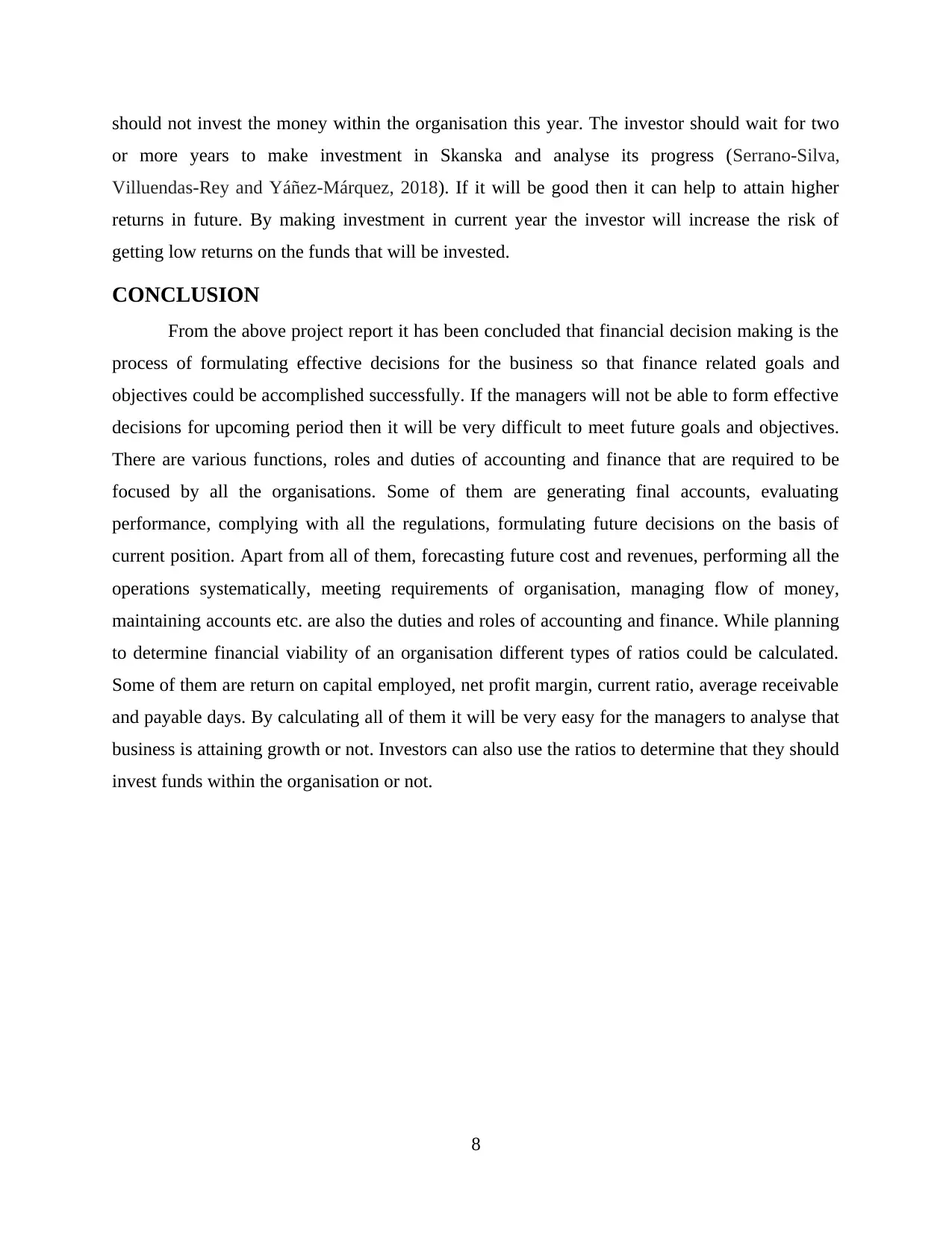
should not invest the money within the organisation this year. The investor should wait for two
or more years to make investment in Skanska and analyse its progress (Serrano-Silva,
Villuendas-Rey and Yáñez-Márquez, 2018). If it will be good then it can help to attain higher
returns in future. By making investment in current year the investor will increase the risk of
getting low returns on the funds that will be invested.
CONCLUSION
From the above project report it has been concluded that financial decision making is the
process of formulating effective decisions for the business so that finance related goals and
objectives could be accomplished successfully. If the managers will not be able to form effective
decisions for upcoming period then it will be very difficult to meet future goals and objectives.
There are various functions, roles and duties of accounting and finance that are required to be
focused by all the organisations. Some of them are generating final accounts, evaluating
performance, complying with all the regulations, formulating future decisions on the basis of
current position. Apart from all of them, forecasting future cost and revenues, performing all the
operations systematically, meeting requirements of organisation, managing flow of money,
maintaining accounts etc. are also the duties and roles of accounting and finance. While planning
to determine financial viability of an organisation different types of ratios could be calculated.
Some of them are return on capital employed, net profit margin, current ratio, average receivable
and payable days. By calculating all of them it will be very easy for the managers to analyse that
business is attaining growth or not. Investors can also use the ratios to determine that they should
invest funds within the organisation or not.
8
or more years to make investment in Skanska and analyse its progress (Serrano-Silva,
Villuendas-Rey and Yáñez-Márquez, 2018). If it will be good then it can help to attain higher
returns in future. By making investment in current year the investor will increase the risk of
getting low returns on the funds that will be invested.
CONCLUSION
From the above project report it has been concluded that financial decision making is the
process of formulating effective decisions for the business so that finance related goals and
objectives could be accomplished successfully. If the managers will not be able to form effective
decisions for upcoming period then it will be very difficult to meet future goals and objectives.
There are various functions, roles and duties of accounting and finance that are required to be
focused by all the organisations. Some of them are generating final accounts, evaluating
performance, complying with all the regulations, formulating future decisions on the basis of
current position. Apart from all of them, forecasting future cost and revenues, performing all the
operations systematically, meeting requirements of organisation, managing flow of money,
maintaining accounts etc. are also the duties and roles of accounting and finance. While planning
to determine financial viability of an organisation different types of ratios could be calculated.
Some of them are return on capital employed, net profit margin, current ratio, average receivable
and payable days. By calculating all of them it will be very easy for the managers to analyse that
business is attaining growth or not. Investors can also use the ratios to determine that they should
invest funds within the organisation or not.
8
Paraphrase This Document
Need a fresh take? Get an instant paraphrase of this document with our AI Paraphraser
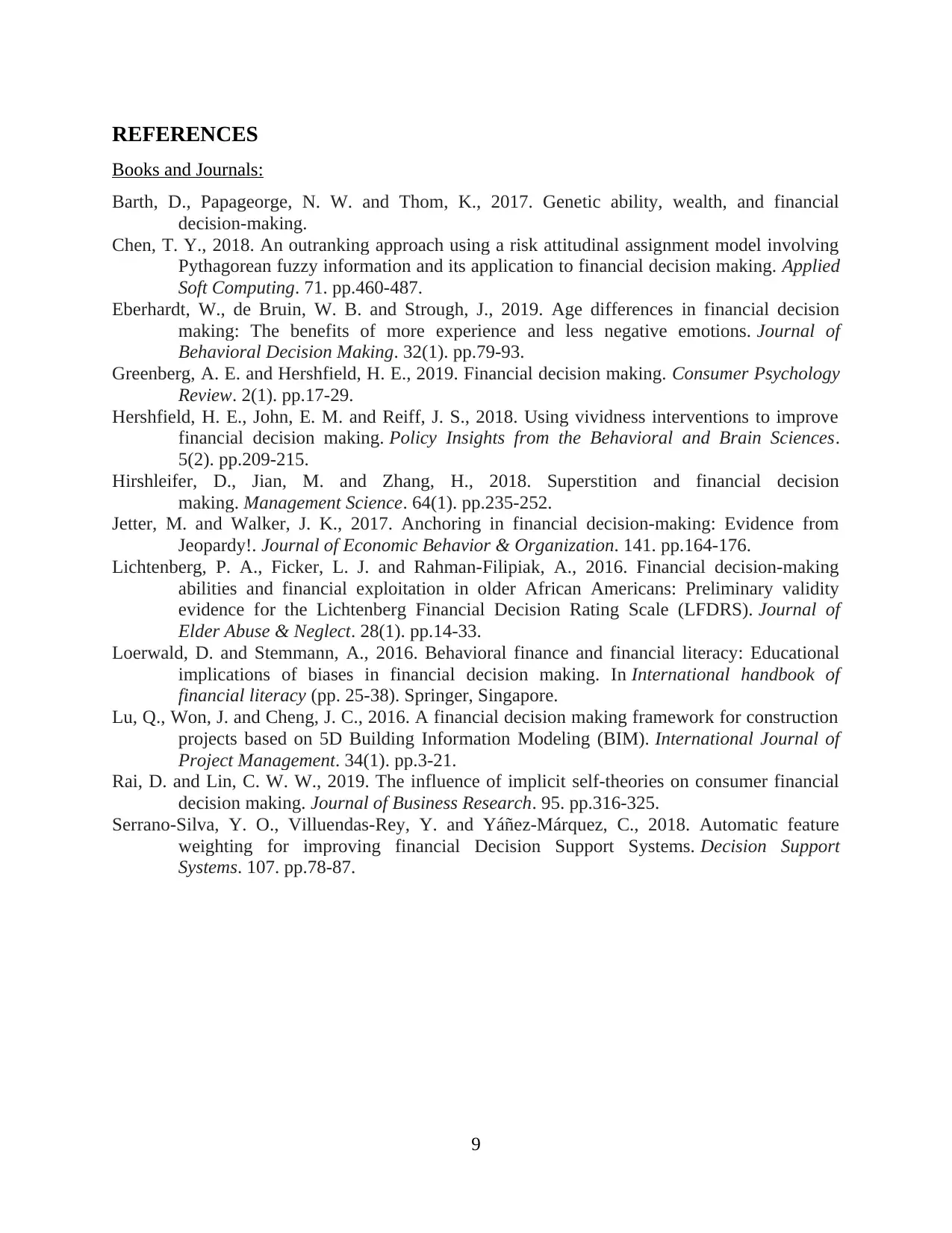
REFERENCES
Books and Journals:
Barth, D., Papageorge, N. W. and Thom, K., 2017. Genetic ability, wealth, and financial
decision-making.
Chen, T. Y., 2018. An outranking approach using a risk attitudinal assignment model involving
Pythagorean fuzzy information and its application to financial decision making. Applied
Soft Computing. 71. pp.460-487.
Eberhardt, W., de Bruin, W. B. and Strough, J., 2019. Age differences in financial decision
making: The benefits of more experience and less negative emotions. Journal of
Behavioral Decision Making. 32(1). pp.79-93.
Greenberg, A. E. and Hershfield, H. E., 2019. Financial decision making. Consumer Psychology
Review. 2(1). pp.17-29.
Hershfield, H. E., John, E. M. and Reiff, J. S., 2018. Using vividness interventions to improve
financial decision making. Policy Insights from the Behavioral and Brain Sciences.
5(2). pp.209-215.
Hirshleifer, D., Jian, M. and Zhang, H., 2018. Superstition and financial decision
making. Management Science. 64(1). pp.235-252.
Jetter, M. and Walker, J. K., 2017. Anchoring in financial decision-making: Evidence from
Jeopardy!. Journal of Economic Behavior & Organization. 141. pp.164-176.
Lichtenberg, P. A., Ficker, L. J. and Rahman-Filipiak, A., 2016. Financial decision-making
abilities and financial exploitation in older African Americans: Preliminary validity
evidence for the Lichtenberg Financial Decision Rating Scale (LFDRS). Journal of
Elder Abuse & Neglect. 28(1). pp.14-33.
Loerwald, D. and Stemmann, A., 2016. Behavioral finance and financial literacy: Educational
implications of biases in financial decision making. In International handbook of
financial literacy (pp. 25-38). Springer, Singapore.
Lu, Q., Won, J. and Cheng, J. C., 2016. A financial decision making framework for construction
projects based on 5D Building Information Modeling (BIM). International Journal of
Project Management. 34(1). pp.3-21.
Rai, D. and Lin, C. W. W., 2019. The influence of implicit self-theories on consumer financial
decision making. Journal of Business Research. 95. pp.316-325.
Serrano-Silva, Y. O., Villuendas-Rey, Y. and Yáñez-Márquez, C., 2018. Automatic feature
weighting for improving financial Decision Support Systems. Decision Support
Systems. 107. pp.78-87.
9
Books and Journals:
Barth, D., Papageorge, N. W. and Thom, K., 2017. Genetic ability, wealth, and financial
decision-making.
Chen, T. Y., 2018. An outranking approach using a risk attitudinal assignment model involving
Pythagorean fuzzy information and its application to financial decision making. Applied
Soft Computing. 71. pp.460-487.
Eberhardt, W., de Bruin, W. B. and Strough, J., 2019. Age differences in financial decision
making: The benefits of more experience and less negative emotions. Journal of
Behavioral Decision Making. 32(1). pp.79-93.
Greenberg, A. E. and Hershfield, H. E., 2019. Financial decision making. Consumer Psychology
Review. 2(1). pp.17-29.
Hershfield, H. E., John, E. M. and Reiff, J. S., 2018. Using vividness interventions to improve
financial decision making. Policy Insights from the Behavioral and Brain Sciences.
5(2). pp.209-215.
Hirshleifer, D., Jian, M. and Zhang, H., 2018. Superstition and financial decision
making. Management Science. 64(1). pp.235-252.
Jetter, M. and Walker, J. K., 2017. Anchoring in financial decision-making: Evidence from
Jeopardy!. Journal of Economic Behavior & Organization. 141. pp.164-176.
Lichtenberg, P. A., Ficker, L. J. and Rahman-Filipiak, A., 2016. Financial decision-making
abilities and financial exploitation in older African Americans: Preliminary validity
evidence for the Lichtenberg Financial Decision Rating Scale (LFDRS). Journal of
Elder Abuse & Neglect. 28(1). pp.14-33.
Loerwald, D. and Stemmann, A., 2016. Behavioral finance and financial literacy: Educational
implications of biases in financial decision making. In International handbook of
financial literacy (pp. 25-38). Springer, Singapore.
Lu, Q., Won, J. and Cheng, J. C., 2016. A financial decision making framework for construction
projects based on 5D Building Information Modeling (BIM). International Journal of
Project Management. 34(1). pp.3-21.
Rai, D. and Lin, C. W. W., 2019. The influence of implicit self-theories on consumer financial
decision making. Journal of Business Research. 95. pp.316-325.
Serrano-Silva, Y. O., Villuendas-Rey, Y. and Yáñez-Márquez, C., 2018. Automatic feature
weighting for improving financial Decision Support Systems. Decision Support
Systems. 107. pp.78-87.
9
1 out of 11
Related Documents
Your All-in-One AI-Powered Toolkit for Academic Success.
+13062052269
info@desklib.com
Available 24*7 on WhatsApp / Email
![[object Object]](/_next/static/media/star-bottom.7253800d.svg)
Unlock your academic potential
Copyright © 2020–2025 A2Z Services. All Rights Reserved. Developed and managed by ZUCOL.





